 |
||
|
|
|
Celebrating the pipe organ, the King of Instruments |
Pipedreams Euro-Tour
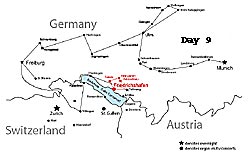 |
April 28 - May 11, 2006
Day 9 -
Weingarten, Weissenau & Salem
 Notes from the Road - travel log, day 9
Notes from the Road - travel log, day 9 Michael Barone’s pictures from the tour
Michael Barone’s pictures from the tour Images from Weingarten Basilica
Images from Weingarten Basilica Images from Weissenau Basilica
Images from Weissenau Basilica Images from Salem Minster
Images from Salem Minster Day 8 - Villingen & Überlingen
Day 8 - Villingen & Überlingen Day 10 - Lindau & Dornbin
Day 10 - Lindau & Dornbin Main Tour Page
Main Tour Page
Weingarten (Basilica)
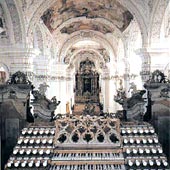 |
In 934, Duke Henry founded an abbey that was transfered in 1053 to today’s site and was named “Weingarten”. Since 1056, Benedictine monks have settled here and built a new church and cloisters in 1124, one of the largest in Swabia. Since 1712, plans were underway to built the abbey church that is still in use today. The church was completed and consecrated in 1724. It is the largest baroque church north of the Alpes. The architects were Christian Tumb and Peter Schreck. The west fassade with the two towers as well as the dome above the crossing were built after plans of Donato Giuseppe Frisoni. The frescoes in the vaults and ceilings have been created by Cosmas Damian Asam, the choir stalls (1724) are carved by Joseph Anton Feuchtmayer. The towers house seven large bells (a″ - c-sharp′ - e′ - f-sharp′ - g-sharp′ - b′ - c-sharp″. There is an additional bell in the North tower (Hosanna bell, b°, weight of c. 6.500 kg, from 1490). Since 1922, 120 years after the secularisation of the abbey, Benedictine monks from Beuron are back in Weingarten Abbey.
Earliest organs for the previous churches have been mentioned in the 13th century, replaced by new organs in 1561 and 1613. When in 1715 the old minster had been dismantled and was replaced by the present abbey church in 1724, plans were made for the building of a representative new organ. In 1729, the abbey chapter’s attention was drawn to a young organ builder, Joseph Gabler, who at that time just was working at the rebuiling of the organ in Ochsenhausen. Gabler was asked to repair the Weingarten choir organ, and after he done these works successfully and also completed the new organ in Ochsenhausen in 1733, it was decided in 1737 to ask him to built the new organ in Weingarten.
In a first contract from 1737, the organ should comprise 60 stops and some percussion stops like Glockenspiel, Cimbala, Rossignol, playable on four manuals and pedal. The compasses should have on the manuals C-c3, in the pedal C-g°, with all 12 chromatic notes in the lowest octaves . The wind supply system in the North tower should have 12 bellows. Most parts of the organ should be playable within three years.
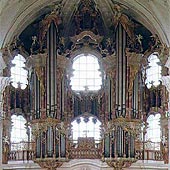 |
With a third contract, it was tried in 1741 to get the dead-locked negotiations for both organs moving again. Gabler was promised 10.000 guilders, but had to carry out further works without payment, such as some carvings in the facade, manufacturing the ivory keyboards and building a 3-stop procession organ. In this contract, we can discovers Gablers sense for constellations of numbers:
Great Organ: 76 stops = 6666 pipes
Choir Organ: 24 stops = 2222 Pfeifen
Total: 100 stops = 8888 Pfeifen
After a fourth contract, dating in 1746, and a total time of 13 years of building these organ, finally, the great organ was completed and inaugurated on June 24, 1750.
n the early years, when the church was a Cistercian Abbey, there was no organ in Salem. From 1450 on, a first organ was mentioned. 1511, a smaller instrument was added in the North transept. Both organs were destroyed by fire in 1697. The famous Salzburg organbuilder Johann Christoph Egedacher replaced these organs by two new instruments in 1714 and 1720. For the chancel, a third one was built in 1752 by Johann Georg Aichgasser.
It was Abbot Anselm II. who, in the course of the Classic refurbishing of the sanctuary, helped to achieve the famed reputation of Salem as home of four of the most beautiful and important Baroque organs, built by Karl Joseph Riepp (1710-1775) between 1766 und 1774 with a total of 129 speaking stops:
Links and resources
 Notes from the Road - travel log, day 9
Notes from the Road - travel log, day 9 Images from Weingarten Basilica
Images from Weingarten Basilica Weingarten Abbey website
Weingarten Abbey website Weingarten - Wikipedia
Weingarten - Wikipedia Pipedreams gallery page
Pipedreams gallery page Find detailed organ specifications in our Tour Book
Find detailed organ specifications in our Tour Book
| Return to top |
Weissenau (Basilica)
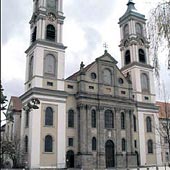 |
 |
The former Premonstratensian Abbey Church was founded in 1145. The middle-age buildings were replaced by the baroque church between, completed in 1724, and still in use as a parish church after the secularization of 1802. In the west fassade, two mighty towers flank the wide nave. They house eight swinging bells (a′ - c-sharp′ - e′ - f-sharp′ - a′ - h′ - c-sharp″ - e″ (cast in 1699 and 1989). The high-altar and the choir-stalls date from 1635, the altar-of-the-cross was given in 1783 as a gift from Salem Abbey. From the middle-age’s interior a Madonna from 1495 is preserved at the left choir arch.
Links and resources
 Notes from the Road - travel log, day 9
Notes from the Road - travel log, day 9 Images from Weissenau Basilica
Images from Weissenau Basilica Pipedreams gallery page
Pipedreams gallery page Find detailed organ specifications in our Tour Book
Find detailed organ specifications in our Tour Book
| Return to top |
Salem (Minster)
The first church buildings were erected in the 12th century. In 1285, the cornerstone of today’s abbey church was laid and the building was completed and consecrated in 1414 by Archbishop Eberhard III of Salzburg. Built in Gothic style with three naves, transept and chancel, the basilica has remained nearly unchanged to this day and is said to be one of the most important Gothic churches in Southern Germany. Unlike the church, the adjacent abbey buildings and cloisters were replaced in the 17th century by a large Baroque construction which burnt down in a fire disaster in 1697. Today’s cloisters have been built between 1697 and 1708 by Franz Beer, an architect from Vorarlberg.
The furnishings of the Middle Ages were already given up when the buildings were rebuilt in the 17th century, and the new ones were destroyed by the fire in 1697. Another Baroque interior by Joseph Anton Feuchtmayer was eventually replaced by today’s Classical furnishing (1766-1793) with 27 altars and choirstalls of 88 seats. Note the valuable Gothic tabernacle in the North transept from 1494.
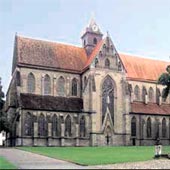 |
In the early years, when the church was a Cistercian Abbey, there was no organ in Salem. The first organ was mentioned in 1450. In 1511, a smaller instrument was added in the North transept. Both organs were destroyed by fire in 1697. The famous Salzburg organbuilder Johann Christoph Egedacher replaced these organs by two new instruments in 1714 and 1720. A third one was built for the chancel in 1752 by Johann Georg Aichgasser.
In 1804, after the secularization, all organs except for the Trinity organ were sold. The pipework of the Tabernacle Organ was sold to Überlingen Minster, but is not preserved. The Notre-Dame Organ was sold to Winterthur Reformed Church, where the case and some stops are preserved. The Choir Organ has disappeared.
The Trinity Organ had been repaired several times when it was decided to replace it at the end of the 19th century. Today’s organ was built in 1901 by Wilhelm Schwarz (Überlingen). Schwarz kept the Baroque case (built by Johann Dirr in 1771) of the old Riepp organ as well as the Riepp facade pipes. Today, the Schwarz organ is considered to be a fine example of 19th century organ art in Germany. In 1983 the organ was declared a protected historical monument.
Links and resources
 Notes from the Road - travel log, day 9
Notes from the Road - travel log, day 9 Images from Salem Minster
Images from Salem Minster Find detailed organ specifications in our Tour Book
Find detailed organ specifications in our Tour Book
| Return to top |


